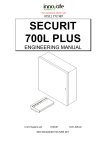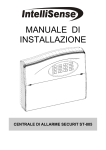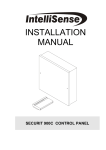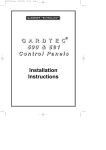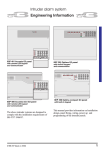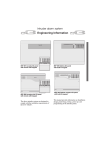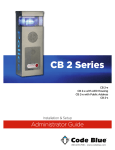Download C&K systems LED Keypad Installation manual
Transcript
INSTALLATION MANUAL SECURIT 800L+ CONTROL PANEL ST800L+ CONTENTS WARNINGS STANDARDS WARRANTY STATEMENT PRODUCT DESCRIPTION AVAILABLE PARTS INTENDED USE SPECIFICATIONS INSTALLATION Mounting Wiring the Control Panel Mounting a Remote Keypad Wiring a Remote Keypad POWERING UP Initial Power Up PROGRAMMING Exit Time Entry Time Sounder Duration Night Set/Home Set Exit Time Circuit Programming Extended Programming Options Home Set Zone Selection Engineer Access Code Engineer Event Log Review Engineer Test Options Factory Programming Defaults GLOSSARY OF TERMS SOUNDER CONNECTIONS FAULT FINDING GENERAL QUESTIONS & ANSWERS 2 3 3 3 3 3 3 4 5 5 5 7 7 7 7 8 8 8 9 9 10 10 10 11 11 11 12 12 14 15 15 WARNINGS Prolonged short circuit of any supply can cause damage to the unit. Take the necessary precautions in not allowing liquids to spill on or into the unit. STANDARDS This unit conforms to ECD 89/336/EEC & LVD 73/23/EEC. It has been tested and proven to meet all current emission and immunity regulations as set out by the EEC. This unit complies with BS4737 part 1 1988 which relates to security control equipment. WARRANTY STATEMENT C & K Systems offers a two and a half year warranty from the date of manufacture for this product. If for some reason the unit fails in the first six months, C & K will replace the unit free of charge. If it fails in the remaining two years, return the unit to C & K systems, and we will test the unit. If it is found customer damaged, a charge will incur. Otherwise the unit will be repaired and returned free of charge. PRODUCT DESCRIPTION The Securit 800L+ is an 8-zone programmable microprocessor control panel using state of the art technology and manufacturing techniques. The control panel has many advanced features that can only be found in more expensive control panels. These features include two user codes, Chime, Fire, and Keypad PA. Many options in the programming functions allow the control panel to be versatile and user friendly. This panel is the ideal choice for residential and light commercial installations. AVAILABLE PARTS The following selection of spares and extras are available: • Remote Keypad - giving full control over the control panel. • Spare PCB - for replacement in the event of failure. • Keyswitch - giving simple set/unset operation. You can obtain these items from your original place of purchase. INTENDED USE This control panel is designed to be used in residential and light commercial applications such as homes, small shops, and so on. 3 SPECIFICATIONS The following information explains the specifications of the panel. PROCESSOR VERSION SPECIFICATION FOR SOFTWARE REVISION NUMBER V2.0 The software revision number is located on the top of the main processor. SPECIFICATION POWER SUPPLY Power Supply Mains Supply Voltage PSU output voltage Maximum output current Aux. current Battery Fuse Panel Quiescent 230 V AC Nominal 13.7 V Nominal 1 A (total) 500 mA Max. 1 A (20 mm) 40 mA KEYPADS Keypads Supply Voltage Quiescent Current Active Maximum number allowed 13.7 V 20 mA 45 mA 6 GENERAL General Normal operating temperature Humidity Dimensions Control Panel Weight Stand by Battery Standby Time (load dependent) Cable run per zone/circuit Cable run (alarm sounder) FACTORY DEFAULTS 4 Factory Defaults User/customer Code 1 User/customer Code 2 Engineer Code Circuit 1 Circuit 2 Circuit 3 Circuit 4 Circuit 5 Circuit 6 Circuit 7 Circuit 8 Full Set Exit Time Night set Exit Time Entry time Sounder Ring Time Chimes For internal use only 0°C to 40°C 10 to 90% R.H. non condensing 263 mm (W) 223 mm (H) 82 mm (D) 2.7 kg Excluding Battery 7.0Ahr max. valnve regulated lead acid 24 hrs with 2.8Ahr nom. 60 hrs with 7.0Ahr nom. based on (panel+keypad+2*PIR=40+20+25+25mA) 100m max with 50mA load 50m max with 7/0.2 cable 100 max with 16/0.2 or 7/0.2 paralleled 1234 Disabled (0000) 7890 Entry Circuit. (Fixed) Alarm Circuit isolated in Night set. Alarm Circuit. Alarm Circuit. Alarm Circuit. Alarm Circuit. Alarm Circuit. P.A (Personal Attack) 30 Seconds 15 Seconds 30 Seconds 15 Minutes Disabled INSTALLATION Locate the control panel out of sight, such as in a hall, or under stairs or a cupboard, where connection is easy and the detector zone and mains cables can be concealed. Avoid areas subject to high temperature or humidity, such as next to a boiler/heater, in an airing-cupboard, or conservatory. INSTALLATION PROCEDURES When fitting the keypad(s), site them where they are not visible from outside, but where there is adequate light and accessibility for the user. MOUNTING 1 2 3 4 5 Remove the lid screws and the lid. Remove the printed circuit board (PCB) or keypad packaging. Place the panel in the selected position and mark three fixing holes. Mount the panel securely using all three mounting hole positions. Attach tamper spring and mount PCB onto the support pillars. MOUNTING PROCEDURE Note: for Mounting Remote Keypad see page 7. WIRING THE CONTROL PANEL WARNING MAINS CONNECTION The panel must be permanently connected to the mains supply in accordance with current IEE wiring regulation. A 5 amp fused spur, installed by a qualified electrician, is strongly recommended. Any fault which could be mains related must be diagnosed and corrected by a qualified electrician to ensure continued safe operation. MAINS POWER WARNING CAUTION: Under certain circumstances the transformer metalwork can reach 70° C. This is normal and well within prescribed limits. Battery Connection Maximum battery size is 12V 7.0Ah. BATTERY SPECIFICATION This panel requires a standby battery to be fitted to provide power in the event of mains failure. A valve regulated lead acid battery must be used. Detector Circuits Connections are provided for up to eight detector circuits of which normally closed detection devices must be used. A common tamper loop is provided for all detection devices marked as 24 HR Tamper. One or more devices may be connected to each alarm circuit. These should be connected in a series configuration. These circuit connections are located to the bottom right of the PCB (see Diagram B). PIR Latch Line (L+) In the event of two or more detectors (motion sensors or glassbreak detectors) being fitted to any single zone, latching detectors should be used. The L+ connection provides this function. It is low (0 V) when unset and high (12 V) when set. It should be connected to the appropriate SET or LATCH terminal in your detector. See glossary for explanation. DETECTOR CIRCUITS LATCH LINE DESCRIPTION 5 DETECTOR RESET Detector reset (L+ when programmed for ID) INTERNAL DEVICES Internal Sounders, Speakers, Strobe and Keyswitch Wiring Some detectors require the removal of power to reset (such as Viper Plus® or Smoke detectors). You can program the L+ terminal to be used as an ID output using option 7-4. The L+ terminal should then be used as the negative supply for these devices. The positive supply should be taken from the AUX +. Diagram A Keyswitch Connections Open = ON Closed = OFF OFF ON A maximum of two 16 ohm speakers may be fitted in parallel. EXTERNAL DEVICES External Sounder & Strobe Diagram A shows the connection for external sounder and strobe. Please note that the sounder trigger is applied negative (Negative ring). STS+ -R AUXILIARY POWER Strobe switched negative trigger. Sounder switched negative trigger Sounder hold off/strobe positive supply. Sounder hold off supply & sounder tamper feed (negative). Sounder tamper return (negative). AUX DC - Detector power The auxiliary power is provided from connections marked AUX. This is to provide the 12 V supply for detectors such as movement or glassbreak detectors. The auxiliary power output is rated at 500 mA max (12 VCD nominal). (See Diagram B.) Diagram B BASIC BOARD LAYOUT 6 MOUNTING A REMOTE KEYPAD 1 2 3 Choose the keypad location, and then mark holes for mounting. Make sure the cable is run through the backbox. Screw the backbox in the selected position, making sure the cable is not twisted. WIRING A REMOTE KEYPAD Use 6 core cable for connection of all remote keypads. MOUNTING REMOTE KEYPADS WIRING REMOTE KEYPADS Connect the cable into the terminals shown in Diagram C, making sure each wire goes to a like-named terminal in the panel. C goes to C, D to D, + to + and - to -. Wire the tamper wires in series with your existing tamper loop. You do not need to identify individual keypads to the system. If you use more than one remote keypad, either wire it back to the control panel or daisy-chain it from another keypad. Wire all connections in parallel with the exception of the tamper circuit which you MUST wire in series. (See the Glossary for series and parallel examples.) Diagram C KEYPAD DIAGRAM POWERING UP INITIAL POWER UP INITIAL POWER UP Note: Keep the lid off the main control panel in order to enter engineer mode. Alternatively, you can enter 7890 # to enter engineer mode. 1 Switch the mains supply ON. The internal sounder then starts. This denotes a tamper alarm. 2 Enter 1 2 3 4 followed by the # (hash) button. This silences the sounder, and the TAMPER LED flashes. This has now acknowledged and cancelled the alarm; however, because either the panel or keypad lid is removed, your main tamper loop is open. This is normal at this time. 3 Connect the battery and walk test the control panel. This ensures all zones are clear. 4 Power Down and complete the wiring of the control panel. NEVER wire the control panel live. 5 Power back up, cancel the alarm, and enter engineering mode by entering 7, 8, 9, 0. The panel is now ready for programming. 7 NO PROGRAMMING NEEDED? If no programming is required, close any lids that are open and press the # key. This exits engineering mode. Then refer to the Users Manual for customer options. EXIT ENGINEERING MODE If at any time you want to exit engineering mode, confirm any options you have selected with the * (STAR) key. Then close ALL tamper circuits and wait for approximately 60 seconds after which the panel automatically exits engineering mode. Pressing the # key manually exits engineering. RE-ENTER ENGINEERING MODE If at any time you want to re-enter engineering mode, enter the engineering code and then press the # key. This forces the panel into engineering mode. Note: If left unattended for approximately 60 seconds, it reverts to day mode. STAY IN ENGINEERING MODE If you need to stay in engineering mode for longer unattended periods, once in engineering mode, open a tamper circuit. The easiest way to do this is to remove the lid of the panel or keypad. PROGRAMMING TIMERS Once the panel is in engineering mode, the following options are available. EXIT TIME EXIT TIME 3-0 (Range 10-90 seconds) Enter 3-0. The factory default is 30 seconds. You can program a new time by entering one key from the following list. Enter 1 Enter 2 Enter 3 Enter 4 Enter 5 Enter 6 10 Seconds. LED 1 on. 15 Seconds. LED 2 on. 30 Seconds. LED 3 on. (Default) 45 Seconds. LED 4 on. 60 Seconds. LED 5 on. 90 Seconds. LED 6 on. After choosing the desired option, press * to confirm. The accept tone then sounds. ENTRY TIME ENTRY TIME 3-1 (Range 10-90 seconds) Enter 3-1. The factory default is 30 seconds. To reprogram the entry time, enter one key from the following list. Enter 1 Enter 2 Enter 3 Enter 4 Enter 5 Enter 6 10 Seconds. LED 1 on. 15 Seconds. LED 2 on. 30 Seconds. LED 3 on. (Default) 45 Seconds. LED 4 on. 60 Seconds. LED 5 on. 90 Seconds. LED 6 on. Press * to confirm the option. The accept tone then sounds. 8 SOUNDER DURATION 3-2 (Range 3-20 minutes) Enter 3-2. The factory default is 15 minutes. You can program a new time by entering one key from the following table. Enter 1 Enter 2 Enter 3 Enter 4 Enter 5 Enter 6 SOUNDER DURATION 3 minutes. LED 1 on. 4 minutes. LED 2 on. 5 minutes. LED 3 on. 10 minutes. LED 4 on. 15 minutes. LED 5 on. (default) 20 minutes. LED 6 on. Press * to confirm the selection. The accept tone then sounds. NIGHT SET/HOME SET EXIT TIME 3-3 (Range 0-90 seconds) Enter 3-3. The factory default is 15 seconds. You can program a new time by entering one key from the following table. Enter 0 Enter 1 Enter 2 Enter 3 Enter 4 Enter 5 Enter 6 NIGHT/HOME SET EXIT TIMER 0 Seconds. All LEDs off (Instant). 10 Seconds. LED 1 on. 15 Seconds. LED 2 on. (default) 30 Seconds. LED 3 on. 45 Seconds. LED 4 on. 60 Seconds. LED 5 on. 90 Seconds. LED 6 on. Press * to confirm the selection. The accept tone then sounds. Note: If extension speakers are fitted in Night and Home set, you can alter the exit sounder volume by the control on the PCB marked VOLUME. Option Code 3-0 3-1 3-2 3-3 Option Description Exit Time (secs) Entry Time (secs) Sounder Duration (mins) Night / Home Exit (secs) Results from choosing option no. 1 2 3 4 5 10 15 30 45 60 10 15 30 45 60 3 4 5 10 15 0 10 15 30 45 60 0 SUMMARY 6 90 90 20 90 After you enter the user code, the sounder starts at the lower controlled volume. The volume increases after 5 seconds if Night or Home set are not selected. Examples Change the full set Exit Time to 60 seconds ENTER THIS 3-0 5 Description Choose Full Set Select 60 seconds Change the Sounder Duration to 3 minutes ENTER THIS 3-2 1 Description Choose Sounder Select 3 minutes Change the Entry Time to 45 seconds ENTER THIS 3-1 4 Description Choose Entry Select 45 seconds * Confirm selection * Confirm selection * Confirm selection 9 CIRCUIT PROGRAMMING CIRCUIT PROGRAMMING 4 (Range 2-7) You can program circuits 2-7 to suit your requirements. Circuit 1 is fixed as a Final exit circuit. Circuit 8 has limited options. ENTER 4-2 4-3 4-4 4-5 ZONE SELECTIONS PROGRAM ZONE 2 3 4 5 ENTER 4-6 4-7 4-8 PROGRAM ZONE 6 7 8 Select the circuit you want to alter. You can then program that circuit by entering one key from the following table. N/S = Night Set Option no. 1 2 3 4 Zones 2-7 Alarm Alarm with walk through Alarm & Isolate in Night Set Alarm, Walk through & Isolate in N/S 5 6 7 8 Alarm, Walk through & N/S Entry Fire Entry Route P.A Zone 8 Alarm Fire PA Momentary Keyswitch See the glossary for descriptions of zone types. After you select the option, press * to confirm. The accept tone then sounds. EXTENDED PROGRAMMING To program zone 3 as an Entry Route enter - 4 3 7 * To program zone 8 as a Keyswitch enter - 4 8 4 * Momentary Keyswitch Turn and hold for 0.5 seconds = FULL SET Turn and hold for 2.0 seconds = PART SET EXTENDED PROGRAMMING OPTIONS 7 (Range 1-8) The control panel offers the following additional options. Enter 7 - 1 Enter 7 - 2 Enter 7 - 3 Enter 7 - 4 Enter 7 - 5 Enter 7 - 6 Enter 7 - 7 Enter 7 - 8 HOME SET ZONE SELECTION 10 Disables sounder and strobe in Night Set. Chime Enable (See User Manual for zone allocation). Full set door sense setting. Convert L+ to ID- output. Allow Manual Isolation of Zone 1 (Entry/Exit) In Night Set. Remote Keypad PA Enable (Operated by * and #). L+ signals first to alarm. Inhibit strobe in Night and Home set and test (for speech dialer connection). Press * to confirm. The accept tone then sounds. HOME SET ZONE SELECTION 8 (Range 1-8 N/A if Fire or PA) The Home Set feature enables parts of the premises to be alarm protected while other parts are occupied and in use. This feature is similar to Night Set except that an Exit/Entry route is not required as part of the Setting or Unsetting procedure. In programming mode press 8 to select Home Set zone selection mode. By pressing the keys 1-8 on the keypad, you can select which zones to be ISOLATED during Home Set. As you press a key, its relevant LED on the display toggles ON or OFF. Any LEDs that are ON are ISOLATED during Home Set, and any that are OFF remain ACTIVE. ENGINEER ACCESS CODE 1-1 The default engineer access code is 7890. To change this code (while in engineering mode), complete the following procedure. 1 Enter 1-1. LEDs 1, 2, 3 and 4 illuminate. 2 Enter the new 4-digit code. After each key-press, one LED goes out. ENGINEER ACCESS CODE The speaker emits an accept tone if the new code is accepted. If the speaker emits an error tone, then your new chosen code is invalid. This could be due to a conflict with another code. At this time your old access code is still valid. Repeat the procedure using a different code. ENGINEER EVENT LOG REVIEW 5 (Choices of set & unset) The panel stores the last 9 set and unset states and the last alarm event. The log is arranged into SET and UNSET events. Log entries indicate the first and subsequent alarms as well as isolated circuits. First to alarm is shown by the LED being ON continuously. Subsequent alarms are shown by the LED(s) flashing, and isolated circuits are shown by LED(s) pulsing slowly. The buzzer sounds whilst reviewing the SET logs and is silent whilst reviewing the UNSET logs. ENGINEER LOG REVIEW To view the engineer logs, press the 5 key from the program mode. The log starts viewing DAY 1 SET. View the remaining logs by pressing the relevant key 2 for 2nd, 3 for 3rd, and so on up to 9. Press the 0 key to get the last alarm condition. The # key alternates between SET and UNSET logs and can be used at any time. Pressing * exits the log displays and returns the main engineering mode. ENGINEER TEST OPTIONS 6 (Range 0-5) To conduct testing activities, first press the 6 key from within engineering mode and then one of the following options. Enter 0 Enter 1 Enter 2 Enter 3 Enter 4 Enter 5 ENGINEER TEST OPTIONS Internal buzzer (entry exit sound etc.) Internal Sounder (Alarm sounds from speaker/keypad) External Sounder External Strobe L+ Terminal (even if programmed as ID-) FULL LOAD (Everything enabled) Press * to finish and return to main engineering mode. 11 FACTORY DEFAULTS FACTORY PROGRAMMING DEFAULTS 9-9 Restoring Programming Defaults RESTORE DEFAULT Enter 9-9. The sounder gives a rapid pipping sound. Wait for 5 seconds. An PROGRAMMING accept tone sounds, and the factory programming defaults are restored. The user and engineer codes do not change. Note: If any keys are pressed, this procedure is aborted. RESTORE DEFAULT CODES Restoring Code Defaults 1 2 3 4 Place the small link supplied with the spare fuses on the memory link. This link is located above the volume control and is labelled Memory Default. Remove the mains and battery supply. Wait a few seconds, and then reconnect the battery and then the mains. Refer to page 7 regarding initial power up. The speaker omits the accept tone, and the factory user code defaults are restored. Be sure to remove the link. Locking the Engineer Code Use this option with care. You can lock the engineer code to prevent unauthorised alteration. To enable this the engineer code must end in 9. If the engineer code is lost, it will not be possible to enter engineer mode; the PCB will need to be replaced. This is considered a chargeable repair. GLOSSARY OF TERMS GLOSSARY OF TERMS FULL SET A setting method to use when leaving the premises. Full system armed. NIGHT SET A setting method to use when going to bed. HOME SET A setting method to use for high security protection whilst still inside the premises (an antiques cabinet, for example). ALARM A zone that triggers the panel when activated, providing the panel is set. WALK THROUGH This zone is disabled during an entry period. ISOLATE IN NIGHT SET The zone is disabled when the panel is NIGHT SET. For example, downstairs may be armed, but upstairs may be disabled. NIGHT SET ENTRY When the panel is NIGHT SET, the zone, when activated, starts the entry timer; but, if the panel is FULL SET, this zone acts as an ALARM zone. 12 ENTRY CIRCUIT Starts the entry timer when activated providing the panel is set. GLOSSARY OF TERMS FIRE (for use with smoke detectors) A zone that when activated emits an ascending sound from any internal speakers. If the panel is set, external sirens and strobes also sound, but in an unset state the external sounders pulse every two seconds. TAMPER A loop that should run through every device on your system. If broken, it triggers the internal speakers. If the panel is set, external sounders and strobes also trigger. The tamper LED appears on the keypad as TPR. CHIME Chime is similar to a doorbell. This can be used to alert a user to a certain zone being triggered during the day. DOOR SENSE SETTING Allows you to have a variable FULL SET EXIT TIME. You can program the EXIT time to maximum, and when you FULL SET the system, the exit time drops to 8 seconds as soon as the EXIT door has closed, thus avoiding the preset exit time. FULL SET KEYSWITCH Allows the panel to be set, unset and reset through zone 8. Note. The keyswitch should be a spring loaded momentary type. To use the keyswitch for setting, unsetting and so on, connect across zone 8 and program that zone to be KEYSWITCH. To SET the panel, turn the key so the contacts are open. Hold in this position for about a second for full set or about 2 seconds for NIGHT SET. To UNSET the panel, turn and hold for about ½ second. To Reset you must open and close the KEYSWITCH after an alarm condition. THE ACCEPT TONE Heard when an action is accepted. THE ERROR TONE Heard when an action is not accepted. SERIES AND PARALLEL LATCHING DETECTORS These detectors, when triggered during a set period, latch on to aid the process of alarm event origin checking. Use these detectors if many detectors are to be used on a single zone but are to cover a large area of space. 13 THIS INFORMATION SHOULD BE KEPT EITHER INSIDE THE CONTROL PANEL OR WITH THE INSTALLER. IT CAN BE USED TO REFER TO PROGRAMMING DETAILS WHEN NEEDED. ZONE ZONE USE / LOCATION 1 2 3 4 5 6 7 8 TIMER FULL NIGHT EXT SOUNDER TICK BOX EXTENDED OPTIONS BATTERY VOLTAGE AUX. VOLTAGE INSTALLED BY RESISTANCE KEYS ENTERED Ω Ω Ω Ω Ω Ω Ω Ω KEYS ENTERED VALUE SECONDS SECONDS MINUTES 1 2 3 4 5 6 7 8 CHECKED V V SOUNDER CONNECTIONS CONTROL PANEL SONADE 2000 ST- S- + - -R STROBE- B D A T FLASHGUARD XL+ STROBE- SIREN- SUPPLY+ SUPPLY- STARLIGHT 2000 ST -R +H -H TAMPER OUT RTN ACTIVEGUARD STB- -S +12V -12V ACTIVE GUARD 3 ST- -SW V+ V- SECURIGUARD STROBE- S- SUPPLY+ SUPPLY- NOVA GUARD 2+T STROBE- S- 12V+ 12V- SPIRIT AU1000 STB- TRG- GENERAL TERMINALS STROBE TRIG - SIREN TRIG - HOLD OFF + SUPPLY+ HOLD OFF SUPPLY- RIGHT HAND TAMPER RET LEFT HAND TAMPER R RTNTAMPER RETURN Note: When installing a self-activating sounder, remove panel link between R- and -. 14 FAULT FINDING A selection of common known problems and solutions are listed below. Problem Programmed 7-5 but zone 1 won’t isolate in night set. Tamper won’t clear with lid on. PA won’t work on the keypad. Mains light not on. Battery not taking over after mains fail. Remote keypad not responding. Zones failing to activate. Zone activates during entry. Zone activates even in day mode. Cause Have not MANUALLY isolated zone when setting panel. Tamper loop open. Not holding * and # long enough or option not enabled No mains. Battery fuse blown, battery not connected, or flat battery. Incorrect wiring. Incorrect wiring. Seeing an alarm zone on entry or deviating from entry route. Programmed to PA or FIRE. Answer When night setting enter code * 0 * 1. Check 24hr tamper, sounder tamper, and all devices for an open tamper loop. Be sure to HOLD * and # until the alarm activates. Enable option 7-6. Check fuse & mains supply. Connect battery and check 1A battery fuse. Fit new battery. Check wiring. C to C and D to D. Make sure the devices are wired in series NOT parallel. Make sure all zones on entry route are programmed with walk-through. Don’t deviate. Reprogram the zone to be an alarm zone or similar. If you are still experiencing problems then contact our technical helpline with information at hand regarding your situation. If your problem stems from wiring, you may be required to write down wiring instructions, so have a pen and paper at hand. General questions & Answers Question Can two bell boxes be used on the system? Can a “sound bomb” be installed? Can the engineer set the panel without the need of the user code? How many PIRS can be connected to a zone? What happens if a zone is still in fault when the bell cuts off? Will there be any further alarms? Answer Yes, make sure tampers are in series and do not exceed the current limit. Yes, connect between AUX+ and S-. Be sure not to exceed maximum current rating. Yes, if the engineering code is entered, the panel will start the set. As many as current supply will allow. Zone resistance should not exceed 50 ohms. The panel will re-arm. Any zones in fault will be temporality isolated, and they will re-arm when the fault clears. Any further alarm activations will trigger the bells again for the selected time. If any zone activates three times in succession, it will be isolated. Alarms can still occur from other zones. 15 Please Note: C & K SYSTEMS is always endeavouring to improve quality and specification of all its products and may alter or amend this product and instructions without notice. C & K Systems Ltd. Unit 24 Walkers Road North Moons Moat Industrial Estate Redditch Worcs. B98 9HE Tel:01527 68111 Fax:01527 68222 Tech Support: Tel: 0345 660533 9am-5pm Weekdays (UK ONLY) C E R TIFIED C O M PA N Y HKQAA Certificate No CC106 Approved email to: [email protected] website: cksys.com C & K is a registered trademark of C & K Components, Inc. Copyright 1999 C & K Systems, Inc. P/N 5-051-613-00 Rev A

















